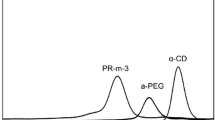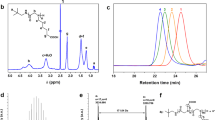Abstract
Poly(ethylene glycol) diamine 1,1’-disubstituted ferrocene was utilized as a size-com-plementary site to synthesize lower coverage pseudopolyrotaxanes (pPRs) from self-assemblies with β- and γ-cyclodextrins (CDs). After end-capping β-CD pPRs using N-(triphenylmethyl)glycine (Trt-Gly-OH), an exact β-CD [3]polyrotaxane (PR) was created. However, an unexpected γ-CD [2]PR and a predictive chain folded stranded γ-CD pPR were identified from end-capped γ-CD pPRs.
Graphic abstract
After end-capping a β-CD pPR self-assembled from β-CDs with amine terminated PEG containing ferrocene as a site-complementary site using Trt-Gly-OH, an exact β-CD [3]PR is invariably created. However, an unexpected γ-CD [2]PR and a predictive chain folded stranded γ-CD pPR are identified from end-capping γ-CD pPRs with Trt-Gly-OH.











Similar content being viewed by others
References
Hashidzume, A., Yamaguchi, H., Harada, A.: Cyclodextrin-based rotaxanes: from rotaxanes to polyrotaxanes and further to functional materials. Eur. J. Org. Chem. 2019(21), 3344–3357 (2019)
Qin, Q., Ma, X., Liao, X., Yang, B.: Scutellarin-graft cationic beta-cyclodextrin-polyrotaxane: synthesis, characterization and DNA condensation. Mater. Sci. Eng. C Mater. Biol. Appl. 71, 1028–1036 (2017)
Takata, T.: Stimuli-responsive molecular and macromolecular systems controlled by rotaxane molecular switches. Bull. Chem. Soc. Jpn. 92, 409–426 (2019)
Song, Q., Luo, Z., Tong, X., Du, Y., Huang, Y.: Glutathione as the end capper for cyclodextrin/PEG polyrotaxanes. Chin. J. Polym. Sci. 32, 1003–1009 (2014)
Du, R., Xu, Z., Zhu, C., Jiang, Y., Yan, H., Wu, H.C., Vardoulis, O., Cai, Y., Zhu, X., Bao, Z., Zhang, Q., Jia, X.: A Highly stretchable and self-healing supramolecular elastomer based on sliding crosslinks and hydrogen bonds. Adv. Funct. Mater. 30, 1907139 (2019)
Choi, S., Kwon, T.W., Coskun, A., Choi, J.W.: Highly elastic binders integrating polyrotaxanes for silicon microparticle anodes in lithium ion batteries. Science 357, 279–283 (2017)
Wang, W., Zhao, D., Yang, J., Nishi, T., Ito, K., Zhao, X., Zhang, L.: Novel slide-ring material/natural rubber composites with high damping property. Sci. Rep. 6, 22810 (2018)
Alvarez-Lorenzo, C., Garcia-Gonzalez, C.A., Concheiro, A.: Cyclodextrins as versatile building blocks for regenerative medicine. J. Control Release 268, 269–281 (2017)
Tamura, A., Yui, N.: Polyrotaxane-based systemic delivery of beta-cyclodextrins for potentiating therapeutic efficacy in a mouse model of Niemann-Pick type C disease. J. Control Release 269, 148–158 (2018)
Tong, X., Yang, F.: Sliding hydrogels with mobile molecular ligands and crosslinks as 3D stem cell niche. Adv. Mater. 28, 7257–7263 (2016)
Jiang, L., Liu, C., Mayumi, K., Kato, K., Yokoyama, H., Ito, K.: Highly stretchable and instantly recoverable slide-ring gels consisting of enzymatically synthesized polyrotaxane with low host coverage. Chem. Mater. 30, 5013–5019 (2018)
Okada, M., Harada, A.: Poly(polyrotaxane): photoreactions of 9-anthracene-capped polyrotaxane. Macromolecules 36, 9701–9703 (2003)
Sun, H., Han, J., Gao, C.: High yield production of high molecular weight poly(ethylene glycol)/α-cyclodextrin polyrotaxanes by aqueous one-pot approach. Polymer 53, 2884–2889 (2012)
Okada, M., Harada, A.: Preparation of β-cyclodextrin polyrotaxane: photodime-rization of pseudo-polyrotaxane with 2-anthryl and triphenylmethyl groups at the ends of poly(propylene glycol). Org. Lett. 6, 361–364 (2004)
Wang, J., Gao, P., Ye, L., Zhang, A.Y., Feng, Z.G.: Solvent- and thermoresponsive polyrotaxanes with β-cyclodextrin dispersed/aggregated structures on a pluronic f127 backbone. J. Phys. Chem. B 14, 5342–5349 (2010)
Huang, K., Li, L., Wang, J., Zhou, Z., Guo, X.: Tunable double-stranded inclusion complexes of γ-cyclodextrin threaded onto non-modified poly(ethylene glycol). Colloid Polym. Sci. 294, 311–319 (2015)
Okada, M., Takashima, Y., Harada, A.: One-pot synthesis of γ-cyclodextrin polyrotaxane trap of γ-cyclodextrin by photodimerization of anthracene-capped pseudo-polyrotaxane. Macromolecules 37, 7075–7077 (2004)
Kobayashi, Y., Nakamitsu, Y., Zheng, Y., Takashima, Y., Yamaguchic, H., Harada, A.: Control of the threading ratio of cyclic molecules in polyrotaxanes consisting of poly(ethylene glycol) and alpha-cyclodextrins. Chem. Commun. 54, 7066–7069 (2018)
Wu, J.S., Toda, K., Tanaka, A., Sanemasa, I.: Association constants of ferrocene with cyclodextrins in aqueous medium determined by solubility measurements of ferrocene. Bull. Chem. Soc. Jpn. 71, 1615–1618 (1998)
Duan, N.N., Lu, H., Ye, L., Zhang, A.Y., Feng, Z.G.: Unexpected polypseudorotaxanes formed from the self-assembly of beta-cyclodextrins with poly( n-isopropylacrylamide) homo- and copolymers. J. Phys. Chem. B 123, 5004–5013 (2019)
Bozna, B.L., Blass, J., Albrecht, M., Hausen, F., Wenz, G., Bennewitz, R.: Friction mediated by redox-active supramolecular connector molecules. Langmuir 31, 10708–10716 (2015)
Ma, M., Luan, T., Yang, M., Liu, B., Wang, Y., An, W., Wang, B., Tang, R., Hao, A.: Self-assemblies of cyclodextrin derivatives modified by ferrocene with multiple stimulus responsiveness. Soft Matter 13, 1534–1538 (2017)
Szillat, F., Schmidt, B.V., Hubert, A., Barner-Kowollik, C., Ritter, H.: Redox-switchable supramolecular graft polymer formation via ferrocene-cyclodextrin assembly. Macromol. Rapid Commun. 35, 1293–1300 (2014)
Nakahata, M., Takashima, Y., Yamaguchi, H., Harada, A.: Redox-responsive self-healing materials formed from host-guest polymers. Nat. Commun. 2, 511 (2011)
Guo, J., Wang, N., Peng, L., Wu, J., Ye, Q., Feng, A., Wang, Z., Zhang, C., Xing, X.H., Yuan, J.: Electrochemically-responsive magnetic nanoparticles for reversible protein adsorption. J. Mater. Chem. B 4, 4009–4016 (2016)
Akae, Y., Iijima, K., Tanaka, M., Tarao, T., Takata, T.: Main chain-type poly-rotaxanes derived from cyclodextrin-based pseudo[3]rotaxane diamine and macro-molecular diisocyanate: synthesis, modification, and characterization. Macromolecules 53, 2169–2176 (2020)
Tamura, A., Nishida, K., Yui, N.: Lysosomal pH-inducible supramolecular dissociation of polyrotaxanes possessing acid-labile N-triphenylmethyl end groups and their therapeutic potential for Niemann-Pick type C disease. Sci. Technol. Adv. Mater. 17, 361–374 (2016)
Knobloch, F.W., Rauscher, W.H.: Condensation polymers of ferrocene derivatives. J. Polym. Sci. 54, 651–656 (1961)
Skinner, P.J., Blair, S., Kataky, R., Parker, D.: A rotaxane of a 1,1’-disubstituted ferrocene and β-cyclodextrin. New J. Chem. 24, 265–268 (2000)
Gao, M., Lu, H., Song, R.H., Ye, L., Zhang, A.Y., Feng, Z.G.: Polyrotaxanes created by end-capping polypseudorotaxanes self-assembled from β-CDs with distal azide terminated PHEMA using propargylamine monosubstituted β-CDs. Polym. Chem. 11, 653–658 (2020)
You, J., Ye, L., Zhang, A.Y., Feng, Z.G.: Synthesis and characterization of matched double-chain and loose-fit single-chain stranded γ-CD-based polypseudorotaxane containing block copolymers. Acta Polym. Sin. 8, 1320–1330 (2017)
Gao, P., Wang, J., Geng, X., Ye, L., Zhang, A.Y., Feng, Z.G.: A study on properties of PEG bent double chain stranded polypseudorotaxanes with γ-cyclodextrins. Acta Chim. Sin. 71, 341–350 (2013)
Acknowledgements
We thank for finacial support from the National Natural Science Foundation of China (No. 21774016).
Author information
Authors and Affiliations
Corresponding author
Ethics declarations
Conflict of interest
The authors declare that they have no conflict of interest.
Additional information
Publisher's Note
Springer Nature remains neutral with regard to jurisdictional claims in published maps and institutional affiliations.
Supplementary Information
Below is the link to the electronic supplementary material.
Rights and permissions
About this article
Cite this article
Song, Rh., Gao, M., Geng, X. et al. Size-complementary effects of PEG diamine 1,1’-disubstituted ferrocene on incorporations of β- and γ-cyclodextrins and syntheses of poly(pseudo)rotaxanes with lower coverages therefrom. J Incl Phenom Macrocycl Chem 102, 99–108 (2022). https://doi.org/10.1007/s10847-021-01104-3
Received:
Accepted:
Published:
Issue Date:
DOI: https://doi.org/10.1007/s10847-021-01104-3




